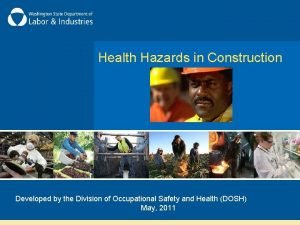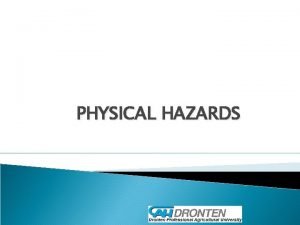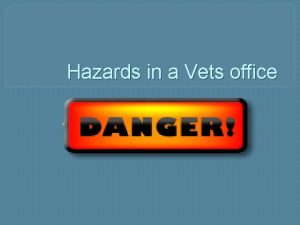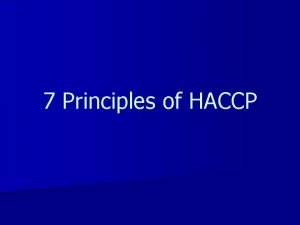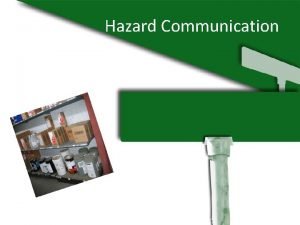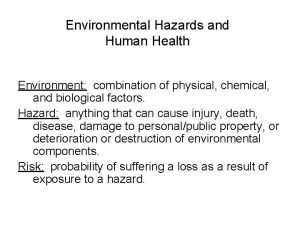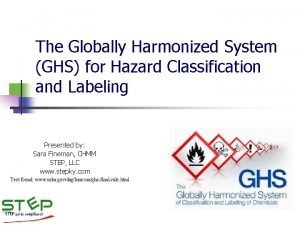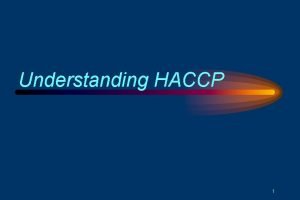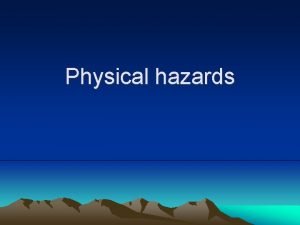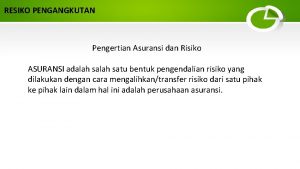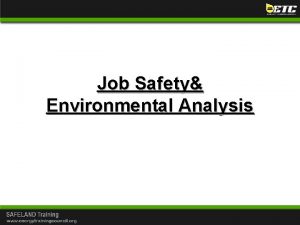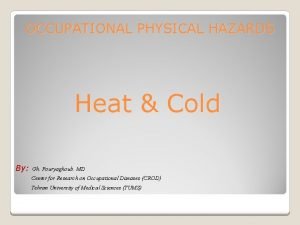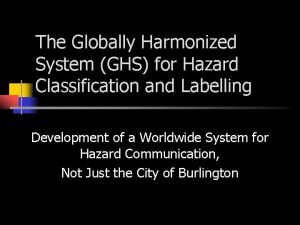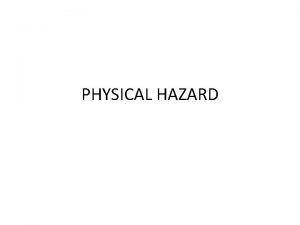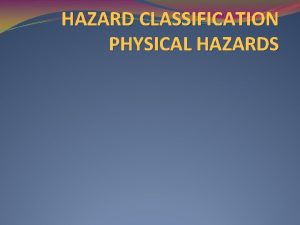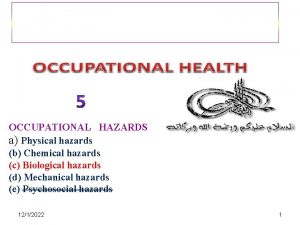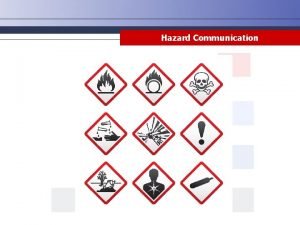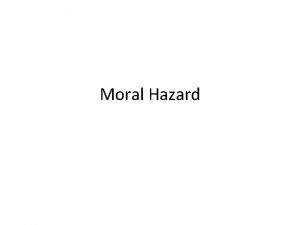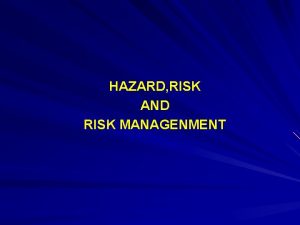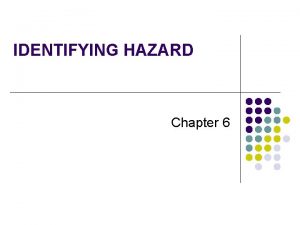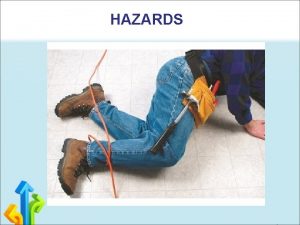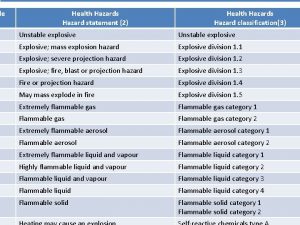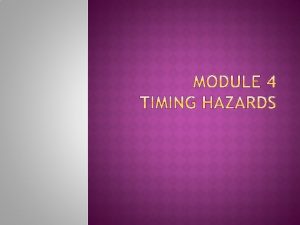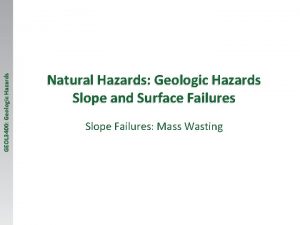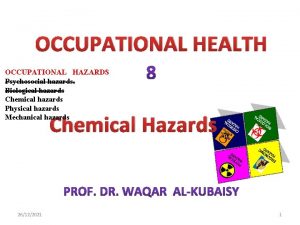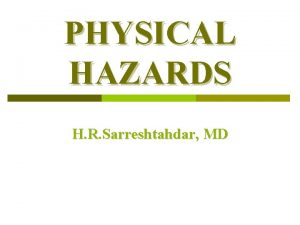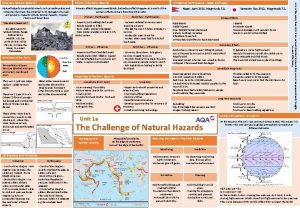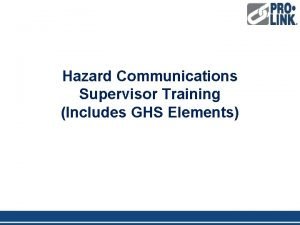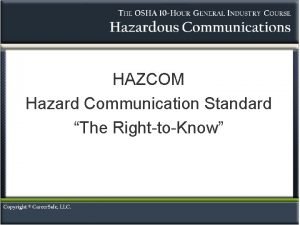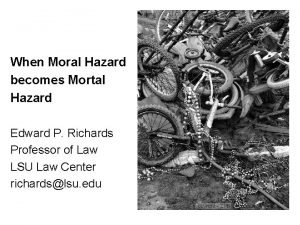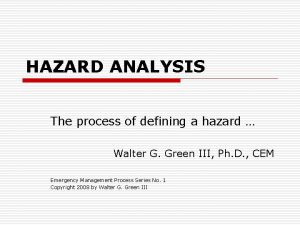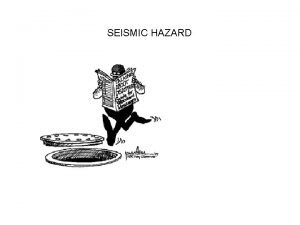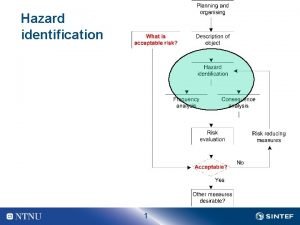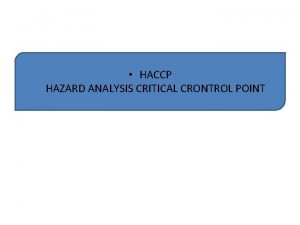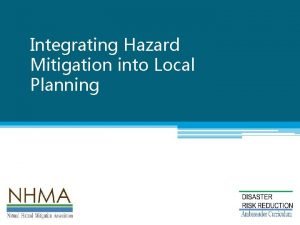PHYSICAL HAZARDS What is the physical hazard Physical































- Slides: 31

PHYSICAL HAZARDS

What is the physical hazard? � Physical hazard: a foreign physical object that can cause an illness or injury � Examples: From raw materials: � Poultry: feathers � Meat: e. g. bone fragments � Fish: fish bones � Vegetables: stones, rocks, dirt � Fruits: stones � Contamination during processing: � Equipment: metal shavings � Production environment: plastic, glass, wood � People: hair, nails, jewelry

How to control physical hazards?

How to control physical hazards? � We ◦ ◦ can also control physical hazards by using: Appropriate design of equipment Metal detectors Good employee hygiene (jewellery) Good sanitation and quality control program

How to control physical hazards? � Physical hazards can be separated or removed by using: screens (rocks, stones), or water bath (dirt from vegetables) etc.

CHEMICAL HAZARDS

What is the chemical hazard? � A toxic substance that present in food can cause an adverse health effect. � You can’t see it in food, can’t feel it when touching, very hard to be removed. � The emphasis – on prevention of contamination and formation

Chemical hazards -examples � � Naturally occurring in food: toxic substances in poisoning mushrooms, arsenic acids in almonds, allergens, alkaloids in potatoes Added intentionally: pesticide residues in feed, nitrates in meat, preservatives Added not intentionally (any unwanted substance): cleaning agents, heavy metals Formed during processing: nitrosamines, acrylamides

Occurance of Chemical Hazards In Meat and Poultry products: Curing agents – nitrates, nitrites (processed red meat) Aflatoxins, pesticides (animal feeds) Growth hormones (in livestock) Growth promoting drugs (in poultry) Cleaners, sanitizing agents (meat and poultry processing plants)

How to control chemical hazards? � Use only legal chemicals (hormones, drugs, cleaners, pesticides, additives) � Use permitted chemicals only below safe levels � Proper procedures � Rinsing � Proper after using cleaners and sanitizers storage of feeds to avoid mycotoxin formation � Storage and labeling for ingredients and raw materials

Role of information

Allergens � List most common food allergens: � …. � Milk � Nuts � Eggs � Soya � Celeriac � Seafood & fish � Wheat � Sesame � Mustard � SO 2

Assignment: How do we control the hazards? CONTROL MEASURES 1. To prevent contamination 2. To prevent growth of bacteria/ formation of toxins 3. To eliminate hazards 4. To eliminate unsafe products YOUR EXAMPLES: Packing…

Organic products

EU spending organic produce


Major goals of organic farming food with appealing authentic tastes, textures and qualities strict prohibition of the use of genetically modified organisms (GMO’s) strict restrictions on the use of: ◦ Chemical synthetic pesticides (herbicides, fungicides…) ◦ Synthetic fertilisers ◦ Antibiotics

High quality produce also by: Multi-annual crop rotations Allowing extended time for plants and livestock to grow to maturity Using indigenous plant varieties and breeds

Processing stage organic produce Strict ban on the use of GMO’s Strict restrictions additives and processing aids Strict restrictions on chemically synthesised inputs.

EU organic farming regulation 2008 Strict rules about labelling and logo use “Any terms such as organic, bio, eco, etc. , or practices used in labelling or advertising liable to mislead the consumer by suggesting that a product meets the requirements of this Regulation shall not be used for non-organic products. ”

Organic: intrinsic or extrinsic Organic food not a product feature, but the consumer’s way of living. Organic menu = attitude ◦ Envolvement of farmer in production of food ◦ Care for environment. ◦ Final goal is healthy and sustainable earth

(Dutch) newspapers about organic food “Organic products score well on food safety. ” or: (Organic products not more healthy!)

Hazards in organic food? Which special hazards can you find in organic food products? Mention a few: 1. 2. 3. 4. 5. -----------

Hazards in organic products? Organic grown broilers contain less salmonella. Organic grown broilers and pig: less resistant against antibiotics. Organic carrots: higher nitrate Organic grown broilers: more Campylobacter Heavy metals: no significant difference. Dioxin: sometimes higher (depending on farming system).

Dioxin levels from laying hens with outdoor run

Dioxin levels from laying hens with outdoor run

Dioxine in eggs (pg TEQ/g fat) Land Nederland* Battery cage Outdoor run 1 -2 1, 3 - 15 1 - 1, 5 4, 5 - 16 Denemarken 0, 9 - 1, 3 1, 9 - 4, 4 Duitsland 0, 8 - 1, 2 3, 2 - 4, 6 1, 3 2, 3 – 19 Ierland 0, 1 - 0, 6 0, 5 – 2, 7 Zweden 0, 6 - 3, 1 België Zwitserland

Harmful products (dioxin) Mother’s milk Fish Poultry Egg Cow Milk Pig Vegetable oil (19, 1 (3, 16 (2, 78 (2, 39 (2, 05 (1, 26 (0, 47 (0, 18 pg/g vet) pg/g vet) pg/g vet)

Conclusions The safety of organc food: is there anything special? Nothing special, sometimes slight differences Perception can be different (consumers expect more safety!

Thanks for attention Questions…? ? ?

SOURCES: � � � � F 4 ST From Farm To Fork Food Safety Specialists Training: ◦ Précon Food Management – Besseling, P. „HACCP – examples of hazard analysis” ◦ Besseling, P. , „Introduction to HACCP”; „Food Safety Technologies” ◦ Caraali, A. , Omeroglu, P. Y. „Introduction to Food Safety”, „HACCP” ◦ Taylor, E. , Clark, K. „HACCP” Codex Alimentarius Commission, “Recommended International Code of Practice-General Principles of Food Hygiene” CAC/RCP 1 -1969, Rev. 4 -2003 Jongen W. M. F. , Luning, P. A. , Marcelis W. J. , “Food quality management a techno-managerial approach” Wageningen Pers, the Netherlands, 2002 http: //www. idfa. org/reg/dectree. pdf -read 2 nd Jan’’ 09 General Principles of Food Hygiene (CAC/RCP 1 -1969, Rev. 4 -2003 http: //www. biologica. nl/bio-monitor/ http: //ec. europa. eu/agriculture/organic/home_nl
 Physical hazards on a construction site
Physical hazards on a construction site Physical hazards
Physical hazards Examples of physical hazards
Examples of physical hazards What is food safety
What is food safety Physical hazards
Physical hazards Physical hazards in a veterinary clinic
Physical hazards in a veterinary clinic 7 principles of haccp
7 principles of haccp Sulfuric acid sds
Sulfuric acid sds Environmental physical hazards
Environmental physical hazards Ghs signal words
Ghs signal words Physical hazards
Physical hazards Physical hazard
Physical hazard Physical hazard noise
Physical hazard noise Contoh physical hazard adalah
Contoh physical hazard adalah Job safety environmental analysis
Job safety environmental analysis Physical hazard heat
Physical hazard heat Pictogram physical hazard
Pictogram physical hazard Alleluia hat len nguoi oi
Alleluia hat len nguoi oi Sự nuôi và dạy con của hươu
Sự nuôi và dạy con của hươu Diễn thế sinh thái là
Diễn thế sinh thái là đại từ thay thế
đại từ thay thế Vẽ hình chiếu vuông góc của vật thể sau
Vẽ hình chiếu vuông góc của vật thể sau Công thức tính độ biến thiên đông lượng
Công thức tính độ biến thiên đông lượng Làm thế nào để 102-1=99
Làm thế nào để 102-1=99 Tỉ lệ cơ thể trẻ em
Tỉ lệ cơ thể trẻ em Thế nào là mạng điện lắp đặt kiểu nổi
Thế nào là mạng điện lắp đặt kiểu nổi Lời thề hippocrates
Lời thề hippocrates Vẽ hình chiếu đứng bằng cạnh của vật thể
Vẽ hình chiếu đứng bằng cạnh của vật thể Quá trình desamine hóa có thể tạo ra
Quá trình desamine hóa có thể tạo ra Các môn thể thao bắt đầu bằng tiếng chạy
Các môn thể thao bắt đầu bằng tiếng chạy Hát kết hợp bộ gõ cơ thể
Hát kết hợp bộ gõ cơ thể Khi nào hổ mẹ dạy hổ con săn mồi
Khi nào hổ mẹ dạy hổ con săn mồi
